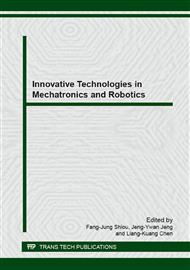[1]
A. Muis and O. Kouhei, An iterative approach in pose measurement through hand-eye calibration, in Proceedings of 2003 IEEE Conference on Control Applications, pp.983-988.
DOI: 10.1109/cca.2003.1223144
Google Scholar
[2]
J. L. Vilaça, J. C. Fonseca, and A. M. Pinho, Calibration procedure for 3D measurement systems using two cameras and a laser line, Optics & Laser Technology, vol. 41, pp.112-119, (2009).
DOI: 10.1016/j.optlastec.2008.05.012
Google Scholar
[3]
C. -C. Ho and C. -L. Shih, A real-time fuzzy reasoning based control system for catching a moving goldfish, International Journal of Control, Automation and Systems, vol. 7, pp.755-763, (2009).
DOI: 10.1007/s12555-009-0508-x
Google Scholar
[4]
D. Samper, J. Santolaria, F. J. Brosed, and J. J. Aguilar, A stereo-vision system to automate the manufacture of a semitrailer chassis, The International Journal of Advanced Manufacturing Technology, vol. 67, pp.2283-2292, (2013).
DOI: 10.1007/s00170-012-4649-3
Google Scholar
[5]
F. Blais, M. Rioux, and J. Domey, Optical range image acquisition for the navigation of a mobile robot, in Proceedings of 1991 IEEE International Conference on Robotics and Automation, pp.2574-2580.
DOI: 10.1109/robot.1991.132015
Google Scholar
[6]
T. Köhler, S. Haase, S. Bauer, J. Wasza, T. Kilgus, L. Maier-Hein, et al., ToF meets RGB: novel multi-sensor super-resolution for hybrid 3-D endoscopy, in Medical Image Computing and Computer-Assisted Intervention-MICCAI 2013, pp.139-146.
DOI: 10.1007/978-3-642-40811-3_18
Google Scholar
[7]
J. Fischer, G. Arbeiter, and A. Verl, Combination of time-of-flight depth and stereo using semiglobal optimization, in Proceedings of 2011 IEEE International Conference on Robotics and Automation (ICRA), pp.3548-3553.
DOI: 10.1109/icra.2011.5979999
Google Scholar
[8]
B. J. Nelson, Y. Zhou, and B. Vikramaditya, Integrating force and vision feedback for microassembly, in Intelligent Systems & Advanced Manufacturing, Springer, pp.30-41, (1998).
Google Scholar
[9]
Y. G. Leclerc, Q. -T. Luong, P. V. Fua, and K. Miyajima, Detecting changes in 3-D shape using self-consistency, in Proceedings of 2000 IEEE Conference on Computer Vision and Pattern Recognition, pp.395-402.
DOI: 10.1109/cvpr.2000.855846
Google Scholar


